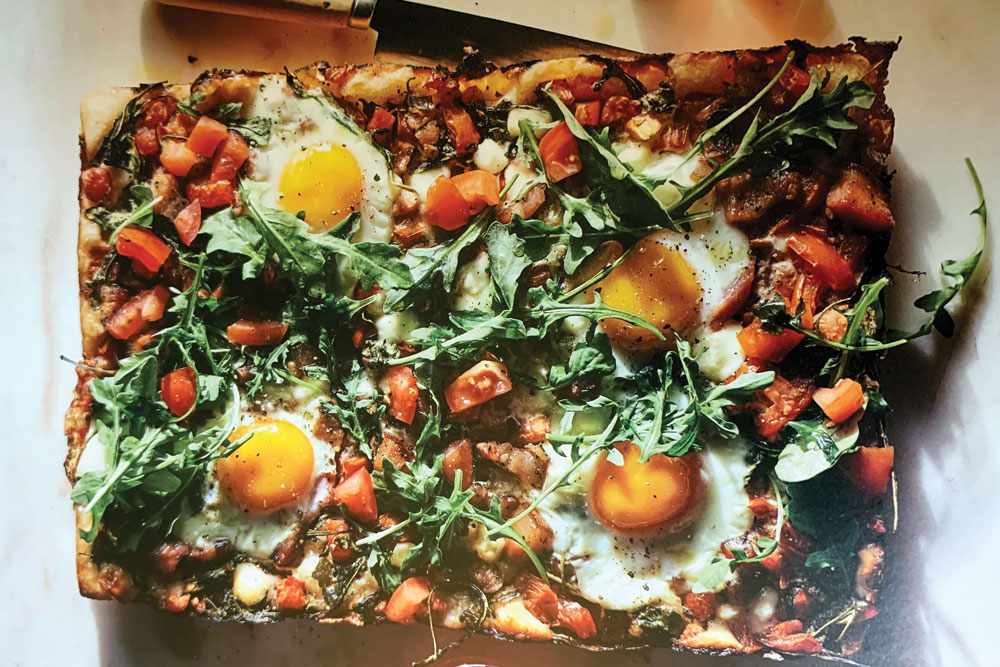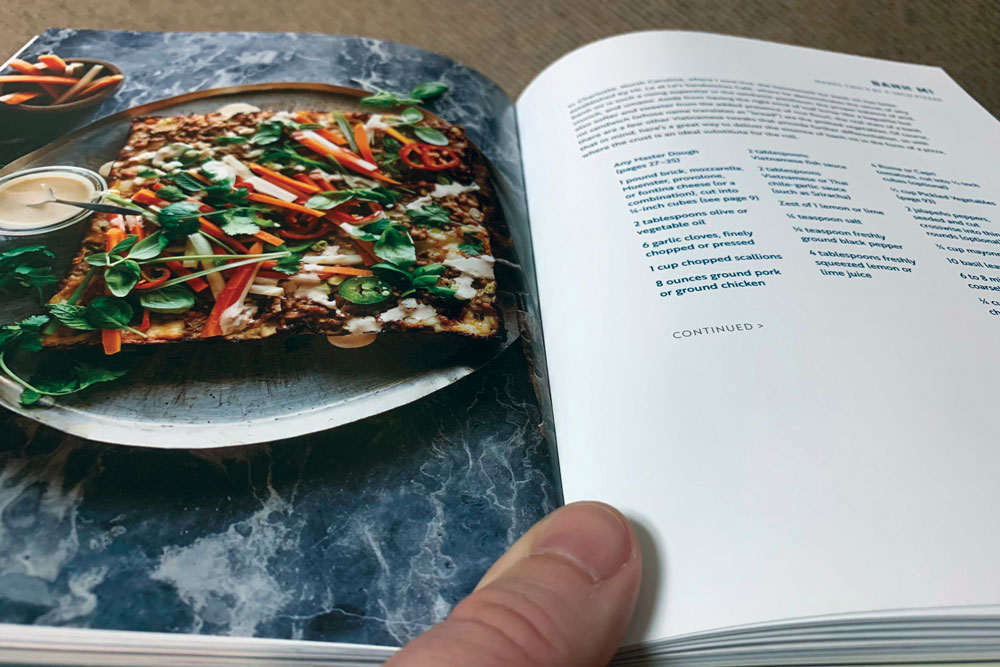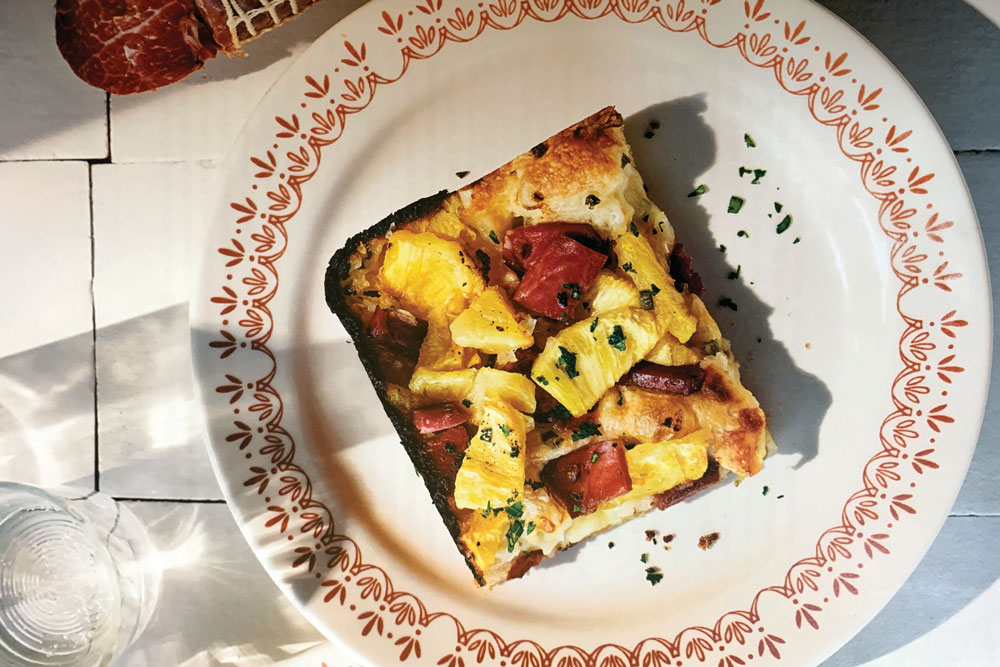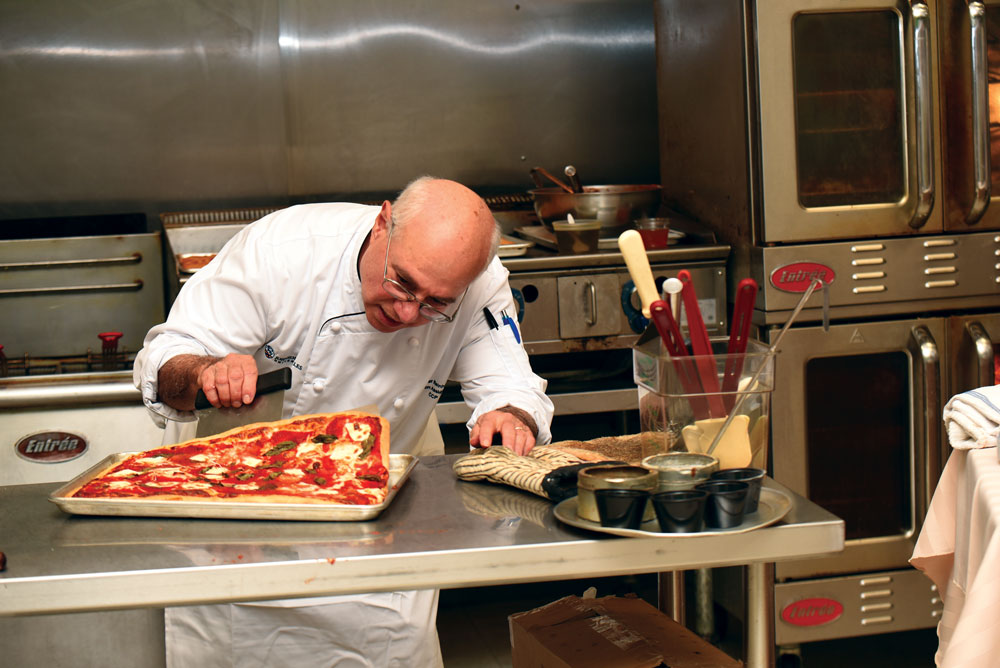In his 2019 book, Perfect Pan Pizza, master baker, pizzaiolo, educator and author Peter Reinhart wrote that we are living in “a new golden age of pizza expression.” That cookbook also put the Detroit pizza style in the limelight, presaging the style’s current boom as one of the segment’s fastest-growing pizza varieties.
A leading authority on bread, a three-time James Beard Award winner, and author of American Pie: My Search for the Perfect Pizza, Reinhart early on developed a special appreciation for pan pies, from focaccia and schiacciata to Sicilian, Roman and Detroit-style pies. Brian Hernandez, PMQ’s test chef, sat down with Reinhart, who’s also known for the Pizza Quest with Peter Reinhart blog, to learn more about what makes pan pizzas so special. In the process, Reinhart shared his technique of embedding cheese in Detroit-style pizza dough, mounted a staunch defense of Hawaiian pizza, and reflected on his wild journey from Gospel-preaching hippie to a bread-baking legend.
Brian Hernandez: The Food Network named Perfect Pan Pizza one of the best cookbooks of 2019. Tell us about it.
Peter Reinhart: This was my second pizza book but my 12th book overall on numerous baking subjects. American Pie, my first pizza book, covered all styles of pizza in the United States. Perfect Pan Pizza is more of a cookbook, featuring my method of doing pan pizzas, anything from Detroit-style to Grandma to Sicilian to focaccias.
Hernandez: Why focus on pan-style pizzas?
Reinhart: Sometimes I get asked to judge pizza competitions, and most of them are focused on Neapolitan or New York-style pizzas. But if they offer a nontraditional or anything-goes category, I noticed more and more of the entries coming in were Detroit-style or square or deep-pan pizzas (which is a different category from deep-dish). People are discovering how good they can be when properly executed. This whole category is ready to explode.
Related: The Square Beyond Compare: 8 Facts You Must Know About Detroit-Style Pizza
Hernandez: What inspired these recipes?
Reinhart: With my background on the baking side, I always have concepts and ideas about what makes a great crust. A lot of it has to do with long, slow fermentation—slow is better than fast—plus proper heat and the balancing act of time, temperature and ingredients to create the optimum flavor experience. As I was working on Perfect Pan Pizza, I knew I wanted to include some of the classics, like the Detroit Red Stripe pizza, but I also wanted to include my own original ideas. The inspiration for those is sandwiches. I define pizza as dough with something on it. I define a sandwich as dough with something in it. They’re really kissing cousins. I wanted to mine the category of my favorite sandwiches—the Philly cheesesteak is a no-brainer, for example, but I wanted to do my own pizza version. Philly is also famous for its roast pork sandwiches, so I engineered my own version of that. To capture the flavor experience of those great sandwiches—a BLT or a Reuben—and do a pizza version of them, that’s one way to get inspired.
Also, as I mentioned, you always need a great crust. So Perfect Pan Pizza had a dual focus—half cookbook and half baking manual for making a great pan-style pizza.

Photo by Johnny Autry
Hernandez: But Detroit pizzas dominate the book, right?
Reinhart: Detroit-style pizza is the star of the book. What makes it the star is its crackly, buttery undercrust that shatters in your mouth like a piece of toffee and fills your mouth with buttery goodness, followed by all the flavors that come behind it.
Hernandez: How did you get into the baking business?
Reinhart: I did not ever imagine I would be a baker. I started out as a communications major in college. I wanted to write and direct films. Then I fell in with a group of hippies in the ’60s, and we started an organic vegetarian restaurant, which was a relatively new thing back then. I fell in love with that life and learned to cook in the kitchen, but I didn’t bake the bread then. We got our bread from another hippie bakery around the corner. I would just go pick up the bread, but I would watch those guys in action, using natural leavenings and whole grains, and that got me interested in the baking side.
Prior to leaving film school, I knew I could make films, but I didn’t know what I had to say in them. I felt I needed to figure out what my mission in life was, what I believed, and kind of find myself. And I found myself through the food world.
Eventually, I joined a Christian community, and I was on track to become a minister. I ended up being the cook in the seminary, because I was the only one that had prior cooking experience. This was in San Francisco, the bread epicenter of the United States, which is where I tapped into the bread culture. I decided to try to make some of my own, and, like a lot of bread bakers, I fell into it so deep I couldn’t get out. Then I met my wife in the church. She was also a good cook, so we started a restaurant/bakery in Sonoma County back in 1986, where we made our own bread. Baking still wasn’t my life’s direction, but I got really good at it, making interesting and unique breads, and then it clicked: “Now I know what I want to write about—telling a story about breads as a metaphor of my own personal journey.”

Hernandez: Not counting bread, what’s your favorite food?
Reinhart: The first dish my mom made for me that blew my mind was a Caesar salad. There was something about that flavor combination—the acidity of the lemon and vinegar, the umami aspect of the anchovies, the olive oil, the garlic, the Parmesan. Those flavors came together in a way that totally changed my relationship with food. It was a breakthrough dish for me. Salad dressing, in fact, plays a big role in my book. It’s more than a garnish. It brings out flavor.
Hernandez: Why do you think pizza is the most popular food in the world?
Reinhart: It’s all about the flavor rule. Customers want you to deliver one thing: Flavor. Whoever delivers the most flavor wins. What is the most perfect flavor delivery system in the world? As I said earlier, it’s dough with something on it or dough with something in it. Whether executed at the highest level or at an average level, both still deliver. Now pizzeria operators have learned how to deliver not just flavor, but flavor that’s memorable. My definition of a great pizza, as opposed to a good pizza, is one that’s memorable.
Hernandez: I’m going to name three ingredients. How would you incorporate these into a pizza? Let’s start with baked beans.
Reinhart: When I think of baked beans, I think of how well it goes with barbecue. Add a little barbecue sauce to baked beans, and you move them into a more acidic direction. For a pizza, I would do it with shredded pork or beef, acidify the beans a bit, and make a sauce that drizzles over the top of the meat, then bake it. I might sprinkle in some fresh onions or pickles, something with a crunch factor to balance the soft texture of the beans.
Hernandez: Portobello mushrooms?
Reinhart: That’s a good ingredient to treat as a meat replacement. I’d probably marinate it in some nice seasonings, maybe a little Worcestershire, soy sauce, garlic, balsamic vinegar or red wine vinegar. I’d grill it in hot oil, fast, giving it a little bit of a crust but keeping the center soft and meaty. I’d cut that into strips and scatter them on the pizza crust. Some people don’t like to mix mushrooms and cheese, but I do, so I’d melt some Swiss or Gruyère cheese on the top of it.
Hernandez: Pickled pineapples?
Reinhart: Pickled pineapples? Wow! We’ve already got the sweetness and the acid, so let’s get some spice in there—maybe some spicy Italian, Portuguese or Mexican sausage, anything with a nice spicy contrast. Besides texture, flavor contrast is important. With the contrast of spicy and sweet, you get more than the sum of its parts.
Hawaiian style is a very polarizing pizza. There are people who get outraged by the idea of it, but they don’t know the origin. It wasn’t created in Hawaii. It was created in Canada by a man who had worked in Chinese restaurants and was fascinated with the flavor experience of sweet and acidic, sweet and sour, the whole Asian flavor profile, as well as spicy flavors. He was on to something, a valid culinary principle that Wolfgang Puck exploited to the max with the pizzas at Spago. If pizza is dough with something on it, who says it has to be Italian food on top? Why can’t pizza be a global food, as long as it passes the flavor rule? Done well, the Hawaiian pizza meets the flavor rule.
Hernandez: While we’re on the subject, tell us about the Motor City Hawaiian.
Reinhart: It’s a Detroit pizza done in the Hawaiian style. (See recipe below.) One of the techniques that differentiates mine from everyone else’s version is the embedded cheese technique that I developed. I’ve never seen this done anywhere else. Once the dough’s in the pan, you take half of your cheese and put it over the surface of the dough. Then you let the dough rise slowly for four to five hours at room temperature, and it embeds the cheese in the crust itself. Finally, you add the rest of the toppings and cheese before baking. This crust has a quality that I’ve never seen in a pizza crust. You get that great toffee-like, caramel bottom plus a creamy, custard-like crumb and, of course, the crispy cheese edge on the outside of the crust. This is part of the technique I use for any of the Detroit-style pizzas in my book.
One criticism of the Detroit style is that a lot of the crusts are too bready. I wanted to create a crust that’s satisfying in its own right. It might look thick, but it doesn’t taste thick—it tastes creamy and has that crunchy, crackle-like quality on the bottom. The cheese is the secret. You can use a combination of cheeses here. There are so many that will work.
Hernandez: So you’re not concerned about the perception of authenticity in your Detroit- or Hawaiian-style pizza?
Reinhart: I think authenticity can be an overused term. It should imply a flavor quality and a standard, but a lot of times it just means you followed an authentic recipe but didn’t execute it very well. Who cares if it’s authentic or not, if it’s not well-executed? Authenticity is a way of preserving an origin story and a way of executing that approach that works. The VPN rules preserve a technique, but some of the best Neapolitan pizzas are not following those rules. They’re following the flavor rule. I think the pizza-police rules are superseded by the flavor rule. If Genarro Lombardi had felt bound by the Neapolitan rules, New York-style pizza wouldn’t exist. We should honor and master the rules, but then feel free to take them to the next level.
Hernandez: If you had to offer one piece of baking advice, what would it be?
Reinhart: Mise en place. It’s a term in French kitchens that means “everything in its place.” Have your system down pat. Make sure your staff knows what it is and follows it. Consistency is key in any kitchen. This is especially helpful in dough production. Have your flour, salt, yeast, oil and water ready and weighed, and know the order in which to mix them. When making dough, the most common mistake is forgetting either the salt or the yeast. If you have a system laid down, this will eliminate that issue. Sure, it’s a simple mistake, but I guarantee you every pizzaiolo has forgotten one or the other at least once in their career.
Brian Hernandez is the coordinator of the U.S. Pizza Team and PMQ’s test chef.
This article originally appeared in PMQ’s September 2019 issue.

Peter Reinhart Pizza Recipe:
The Motor City Hawaiian
Makes four 9″ X 9″ pizzas
Dough ingredients:
- 9” square pan
- 41/3 c. unbleached flour
- 1¾ tsp. kosher salt
- 1¼ tsp. instant yeast
- 2 c. water (60˚F)
- 2 tbsp. olive oil, plus 1 tbsp. additional oil for stretching and folding
Dough directions:
Mix all of your ingredients. Stretch and fold the dough briefly, then cover and let rest for 5 minutes. Uncover and fold the dough again, lightly oiling the surface as needed. Repeat this step four times, then cover and refrigerate for 12 to 72 hours. Use 9 ounces of dough per pan.
Pizza ingredients:
- 1 lb. brick, Muenster, mozzarella, Fontina, cheddar or provolone cheese (or a combination), cut into ¼” cubes
- 4 oz. Canadian bacon, capicola ham or cooked bacon
- ½ c. yellow or white onion, diced
- 1 jalapeño pepper, seeded and diced (optional)
- 1 8-oz. can pineapple chunks or sliced pineapple; or ½ fresh pineapple, peeled and cut into ½” chunks or slices
- ½ c. crushed tomato pizza sauce
- ¼ c. flat-leaf parsley, chopped
Pizza directions:
Five hours before baking the pizza, begin panning the dough, pressing lightly outward with your fingers at 20-minute intervals until it covers the whole pan. Top the dough with half of the cheese cubes and press them into the dough. Allow 4 hours for the final rise. The dough will bubble up around the cheese and rise significantly in the pan.
Cover the dough with an even layer of Canadian bacon, capicola or bacon pieces and sprinkle with the onions. Top with the remaining half of the cheese cubes, making sure to put plenty around the edges, where the dough meets the pan. Spread the pineapple and onions evenly over the cheese. Bake at 500˚F for 8 minutes. Rotate the pan 180˚ and continue to bake for 7 to 9 minutes longer or until the cheese caramelizes to a golden-brown and the pineapple bubbles or chars slightly.
Remove from the oven. Carefully slide an offset spatula or bench blade around the edge, between the crust and the side of the pan, then lift the pizza out of the pan and slide it onto a cutting board. Use a spoon to drizzle the pizza with the pizza sauce after baking. Garnish with the parsley. Let cool for 1 minute, then cut into 3” or 4” squares and serve.















